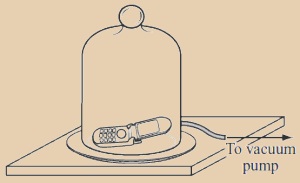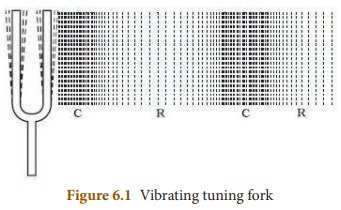Sound | Chapter 6 | 8th Science - Propagation of Sound | 8th Science : Chapter 6 : Sound
Chapter: 8th Science : Chapter 6 : Sound
Propagation of Sound
Propagation of Sound
When you call your friend who is standing at a distance, your friend is able to hear your voice. How your friend is able to hear your voice? He is able to hear because your sound travels from one place to another. As we saw earlier sound is a form of energy and it needs a medium to travel. This can be understood from the activity given below.
Activity 4
Take a bell jar and a mobile phone. Switch on the music in the mobile phone and place it in the jar. Now, pump out the air from the bell jar using a vacuum pump. As more and more air is removed from the jar, the sound from the mobile phone becomes feebler and finally, very faint.

Answer:
Aim : To prove that sound cannot travel through vacuum and it needs a medium for propagation.
Materials Required : Bell jar, mobile phone and vacuum pump.
Procedure :
(i) Take a bell jar and a mobile phone.
(ii) Switch on the music in the mobile phone and place it in the jar.
(iii) Now, pump out the air from the bell jar using a vacuum pump.
(iv) As more and more air is removed from the jar, the sound from the mobile phone becomes feebler and finally, very faint.
Conclusion : This experiment proves that sound cannot travel in vacuum and it needs a medium.
It is clear from this experiment that sound cannot travel in vacuum and it needs a medium like air. Sound travels in water and solids also. The speed of sound is more in solids than in liquids and it is very less in gases.
Thomas Alva Edison, in 1877 invented the phonograph, a device that played the recorded sound.
Activity 5
Take two stones and strike them together and listen to the sound produced by them. Now take the stones underwater and strike them. You will find that the sound produced by the stones underwater is feeble and not very clear.
Answer:
Observation : We observe that the sound produced by the stones undewater is feeble and not very clear.
Conclusion : This activity shows that the speed of sound depends on the properties of the medium through which it travels.
The speed of sound is the distance travelled by sound in one second. It is denoted by ‘v’. It is represented by the expression, v = nλ, where ‘n’ is the frequency and ‘λ’ is the wavelength.
More to know
Wavelength is the distance between two consecutive particles, which are in the same phase of vibration. It is denoted by the Greek letter ‘λ’. The unit of wavelength is metre (m).
Frequency is the number of vibrations of a particle in the medium, in one second. It is denoted by ‘n’. The unit of frequency is hertz (Hz).
Problem 1
A sound has a frequency of 50 Hz and a wavelength of 10 m. What is the speed of the sound?
Solution
Given, n = 50 Hz, λ = 10m
v = nλ
v = 50 × 10
v = 500 ms-1
Problem 2
A sound has a frequency of 5 Hz and a speed of 25 ms-1. What is the wavelength of the sound?
Solution
Given, n = 5 Hz, v = 25 ms-1
v = nλ
λ = v/n = 25/5 = 5 m
The speed of sound depends on the properties of the medium through which it travels, like temperature, pressure and humidity. In any medium, as the temperature increases the speed of sound also increases. For example, the speed of sound in air is 331 ms-1 at 0°C and 344 ms-1 at 22°C. The speed of sound at a particular temperature in various medium are listed in Table 6.1.
Table 6.1 Speed of sound in different medium at 25°C

More to know
The amount of water vapour present in the air is known as humidity. It is less during winter and more during summer. The speed of sound increases with increase in humidity. This is because the density of air decreases with increase in humidity.
We saw that sound travels in different medium with different speed. Now let us see how it travels in a medium. When a body vibrates, the particle of the medium in contact with the vibrating body is first displaced from its equilibrium position. It then exerts a force on the adjacent particle. This process continues in the medium till the sound reaches the ear of the person.
In order to understand this let us consider a vibrating tuning fork. When a vibrating tuning fork moves forward, it pushes and compresses the air in front of it, creating a region of high pressure. This region is called a compression (C) , as shown in Figure 6.1. When it moves backward, it creates a region of low pressure called rarefaction (R). These compressions and rarefactions produce the sound wave, which propagates through the medium.

Related Topics